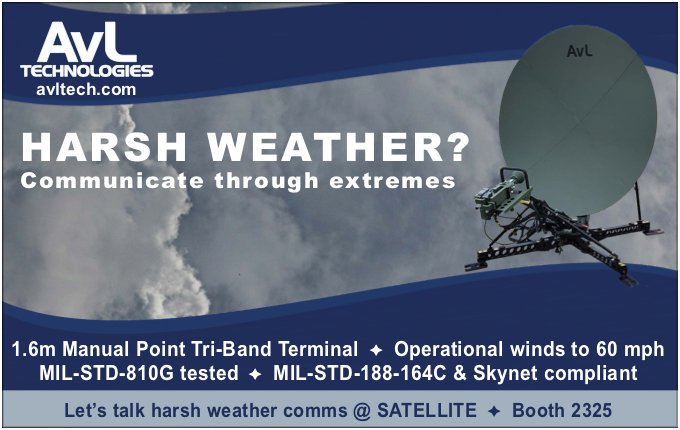Space Systems Command sets A new launch record for the U.S. Space Force
Space Systems Command (SSC) marked a key milestone for the U.S Space Force (USSF) last week, setting a new record with two notable launch accomplishments — placing USSF-67 and GPS III SV06 to orbit in only 61 hours. USSF-67 launched January 15th at 5:56 p.m. ET from Launch Complex-39A at NASA’s Kennedy Space Center, and GPS III SV06 lifted off January 18th at 7:24 a.m. ET from SLC-40, at neighboring Cape Canaveral Space Force Station.
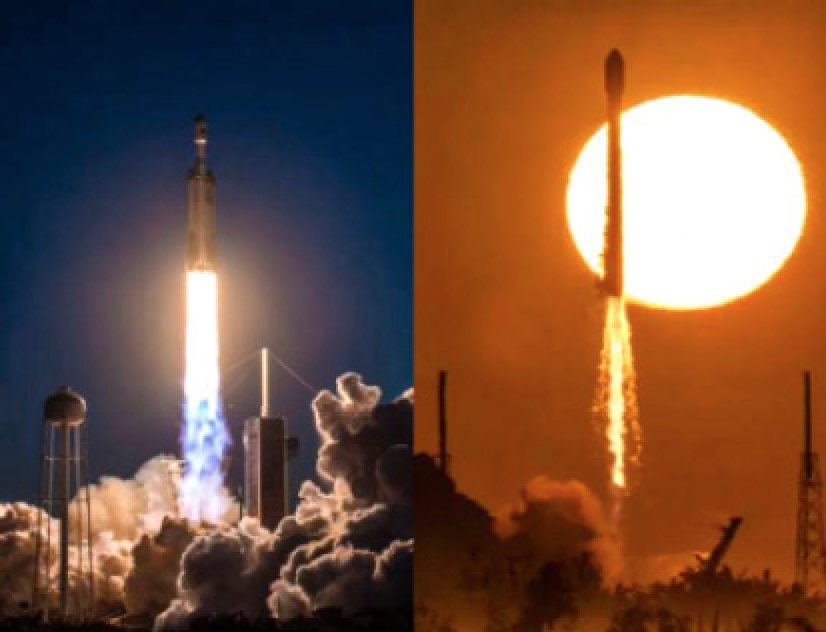
In addition to setting a new record, the two launches shared other achievements as well. Both USSF-67 and GPS III SV06 used previously-flown boosters; USSF-67 was the first NSSL Falcon Heavy to use two refurbished side boosters, which had flown on the USSF-44 mission on November 1, 2022.
The GPS III SV06 mission used a booster recovered and prepped from the Crew-5 Dragon Endurance mission to the International Space Station in October of 2022 for NASA, not a prior NSSL flight. For the program, that was another first as the Space Force continues to evolve its mission assurance processes while still satisfying flight worthiness, commensurate with national security standards.
“With the successful delivery of GPS III SV06, I am pleased to report we set a new launch record in our space history,” said Col. Erin Gulden, senior materiel leader, SSC Assured Access to Space Launch Execution Delta. The closest spacing between two National Security Space Launches (NSSL) of a given vehicle family was previously seven days; a record set in 2014 with United Launch Alliance’s Atlas V 541 lifting the Defense Meteorological Satellite Program (DMSP)-19 from Space Launch Complex (SLC)-3 East at Vandenberg, and the National Reconnaissance Office Launch (NROL)-67 on a ULA Atlas V 401 from SLC-41 at Cape Canaveral. The integrated launch teams just delivered both USSF-67 and GPS III SV06 for the Space Force in just 61 hours! The teamwork and collaboration between the Launch Execution Acquisition Delta, Space Launch Delta 45, SpaceX and our NASA partners were vital to these accomplishments. We challenged and critically evaluated processes and procedures, minimized duplicity and improved synergies across the Falcon program product line.”
The Colonel added, “The program management team, the 2nd Space Launch Squadron and 5th SLS, Air Force/Space Force launch support services (including Range, Safety, and Weather), our technical mission assurance partners from the Aerospace Corporation, our Systems Engineering & Integration team, NASA and SpaceX — all operated incredibly well together and seamlessly. Everything came together masterfully, ensuring we continue to deliver 100 percent NSSL mission success to our satellite customers.”
www.ssc.spaceforce.mil
Airbus to provision MILSATCOM for the Belgian Armed Forces
Airbus has signed a contract with the Belgian Ministry of Defence to provide tactical satellite communications services for a 15 year period of time.
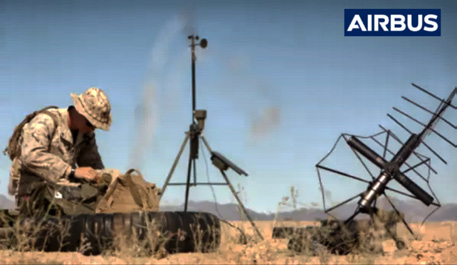
The Belgian Armed Forces will use channels of the Airbus UHF (Ultra High Frequency) military communications hosted payload on-board a commercial telecommunications satellite manufactured by Airbus.
As the UHF frequency band is a relatively scarce orbital resource, this offering will make up for the capacity shortage around the world. Airbus has already signed several firm orders for this capacity, well ahead of the satellite’s scheduled launch.
The UHF payload will be operated from Airbus’s Network Operations Centre (NOC) in Toulouse, France.
The company’s 18 UHF channels will enable up to 200 simultaneous communications over Europe, the Middle East, Africa, large parts of Asia, as well as the Atlantic Ocean (to eastern Brazil) and the Indian Ocean (to western Australia).
Military UHF MILSATCOMs are used by the armed forces for operations on land, at sea and in the air. They have a high level of interoperability and are therefore very useful for multinational and coalition operations.
The UHF band is very flexible and offers a lightweight, robust and highly secure means of communication. An extensive range of terminals for use on land, at sea and in the air is available to meet the needs of the various armed forces.
Airbus has unique experience in operating UHF MILSATCOM services. This new payload will enhance its portfolio throughout the lifespan of the satellite.
Airbus is the only armed forces private SATCOM operator to cover the full spectrum of military (UHF, X-band, Ka Mil) and commercial (L-, C-/Ku-, Ka- band) frequency bands and applications.
“With this new UHF payload, Airbus will be able to offer a new UHF communications service, scheduled for launch in 2024, to the armed forces, particularly those of European countries and NATO allies,” said Eric Even, head of Marketing and Sales, Connected Intelligence, at Airbus Defence and Space.
www.airbus.com/
Kratos Receives Mayhem Hypersonic Missile Program Contract Award
Kratos Defense & Security Solutions, Inc. (Nasdaq: KTOS) Defense & Rocket System Services (DRSS) Division, in collaboration with Kratos’ Unmanned Systems Division, has received a contract from its prime teammate and partner, Leidos, to support the Expendable Hypersonic Multi-Mission ISR (Intelligence, Surveillance, and Reconnaissance) and Strike Program, known as Mayhem.
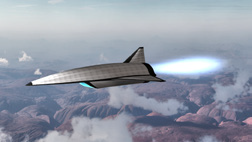
This new contract award will support the Air Force Research Laboratory’s (AFRL) development of an air-breathing hypersonic weapon system over its initial 51-month period of performance. The initial task order will conduct the System Requirements Review (SRR) and Conceptual Design Review (CoDR) in a Digital Engineering (DE) environment.
In partnership with Leidos, Kratos will serve as a member of the System Design Agent (SDA) team for the Mayhem program, which also includes CALSPAN and Draper. The SDA’s goal is to design a system that allows rapid relevant technology insertions using the expertise and capabilities from a variety of industry partners.
The role of the SDA for this program will also include bringing the best of industry together to perform research and development necessary for production of air-breathing multi mission hypersonic system prototypes. The SDA will oversee designs, prototypes, and tests to ultimately produce and deliver a technical data package for high performance, relevant hypersonic weapon systems.
Air-breathing hypersonic systems use scramjet engines to generate thrust, propelling the vehicle across long distances at speeds greater than Mach 5. The SDA team is tasked with designing and developing a large-class version that surpasses current air-breathing systems in both range and payload capacity and is responsible for delivering a hypersonic system design to include airframe, propulsion system, booster, avionics, andvehicle subsystems.
DARPA + NASA collaborate on nuclear thermal rocket (NTR) engine
DARPA, via its Demonstration Rocket for Agile Cislunar Operations (DRACO) program, is collaborating with NASA to build a nuclear thermal rocket (NTR) engine that could expand possibilities for the space agency’s future long-duration spaceflight missions.
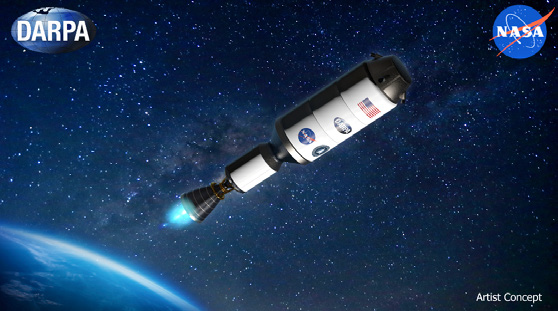
The goal is to test an NTR-enabled spacecraft in Earth orbit during the 2027 fiscal year.
An NTR presents advantages over existing propulsion technologies, such as sending cargo
to a new lunar base, humans to Mars, and robotic missions even farther. NTR propulsion offers a high thrust-to-weight ratio around 10,000x greater than electric propulsion and with two- to-five times greater efficiency than in-space chemical propulsion.
Nuclear thermal rockets have been built before, so DRACO has a head start. About 50 years ago, the technology was tested on the ground.
DRACO is now leveraging lessons learned from past NTR reactor technology, but instead of using highly- enriched uranium, DRACO is using high- assay low-enriched uranium (HALEU) fuel to have fewer logistical hurdles on its ambitious timeline.
As an added safety precaution, DARPA plans to engineer the system so that the DRACO engine’s fission reaction will turn on only once it reaches space.
Fission, the same process used for nuclear power, is the splitting of atoms. It creates high levels of heat that can turn rocket propellant such as hydrogen from a liquid to a gas phase. In the NTR, that gaseous propellant is accelerated out a converging/diverging nozzle in the exact same way as a conventional chemical rocket engine.
The high performance of an NTR is enabled by the reactor passing its heat along to its rocket propellant. DRACO’s proposed solid core NTR temperatures could reach almost 5,000 degrees Fahrenheit, requiring use of advanced materials.
The U.S. Space Force has signaled its support for DRACO with the intent to provide the launch for the demonstration mission.
“DARPA and NASA have a long history of fruitful collaboration in advancing technologies for our respective goals, from the Saturn V rocket that took humans to the Moon for the first time to robotic servicing and refueling of satellites,” said Dr. Stefanie Tompkins, director, DARPA. “The space domain is critical to modern commerce, scientific discovery, and national security. The ability to accomplish leap-ahead advances in space technology through the DRACO nuclear thermal rocket program will be essential for more efficiently and quickly transporting material to the Moon and eventually, people to Mars.”
“NASA will work with our long-term partner, DARPA, to develop and demonstrate advanced nuclear thermal propulsion technology as soon as 2027. With the help of this new technology, astronauts could journey to and from deep space faster than ever – a major capability to prepare for crewed missions to Mars,” said NASA Administrator, Bill Nelson. “Congratulations to both NASA and DARPA on this exciting investment, as we ignite the future, together.”
“NASA is uniquely positioned to provide guidance on the challenging rocket engine and cryogenic fluid management specifications with liquid hydrogen to meet specific mission needs,” said Dr. Tabitha Dodson, DARPA program manager for DRACO. “As the NTR uses propellant more efficiently, it offers more aggressive trajectories and creative burn profiles to move heavy cargo more quickly in the cislunar domain as compared to today’s in-space propulsion methods. We will conduct several experiments with the reactor at various power levels while in space, sending results back to operators on Earth, before executing the full-power rocket engine test remotely. These tests will inform the approach for future operation of NTR engines in space.”
The space domain is essential to modern commerce, scientific discovery, and national defense. Moving larger payloads into farther locations in cislunar space – the volume of space between the Earth and the Moon — will require a leap-ahead in propulsion technology.
The goal of the Demonstration Rocket for Agile Cislunar Operations (DRACO) program is to demonstrate a nuclear thermal rocket (NTR) in orbit. NTRs use a nuclear reactor to heat propellant to extreme temperatures before exhausting the hot propellant through a nozzle to produce thrust. Compared to conventional space propulsion technologies, NTRs offers a high thrust-to-weight ratio around 10,000 times greater than electric propulsion and two-to-five times greater specific impulse (i.e., propellant efficiency) than in-space chemical propulsion.
Phase 1 of the DRACO program involved two tracks.
Track A conducted a baseline design of an NTR reactor.
Track B developed an operational system concept to meet operational mission objectives and a demonstration system design that is traceable to the operational system but focuses on demonstrating the propulsion subsystem.
Phase 2 and Phase 3 of the DRACO program will carry a single performer forward to the flight demonstration, which is envisioned to take place by FY27.
This performer will be responsible for building the NTR and its demonstration system stage.
Phase 2 will involve a cold flow test of the rocket engine without nuclear fuel.
Phase 3 will involve assembly of the fueled NTR with the stage, environmental testing, and launch into space to conduct experiments on the NTR and its reactor.
Orbit Communications to supply SATCOM systems to an APAC navy
Orbit Communications Systems Ltd. (TASE: ORBI) has been awarded a multi-million contract by a leading integrator in South East Asia for the supply of OceanTRx 7MIL SATCOM systems for new naval military platforms.
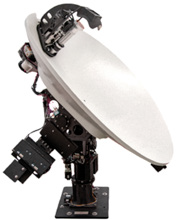
Prior to the signing of the contract, Orbit entered into a teaming agreement with the customer, mainly in the field of maritime SATCOMs, with plans to explore opportunities for cooperation in other regions and fields, such as ground/airborne SATCOMs and AMS. The agreement will also facilitate the improvement of local maintenance, service and support capabilities for new and existing customers.
Ocean TRx 7MIL is a new platform based on the Ocean TRx7 platform, but with advanced military features.
This satellite communication system is intended for use on marine platforms, supporting a variety of antenna system configurations. With a diameter of 2.2 meters, the OceanTRx 7MIL operates on X-, Ku-, Ka- and C-band frequencies, and enables simultaneous operation of a variety of frequencies for global activities.
The OceanTRx 7MIL can be connected to a unique Orbit switching matrix (OSM) which will allow multiple internal connections and switching of up to 8 antennas and 8 modems to according to customers’ requirements. Designed for quick and convenient installation, maintenance and upgrade, the system provides defense customers with a combination of exceptional RF performance and availability.



